Are you new to Scrum and wondering what exactly a Scrum master is supposed to do?
If you’re used to being a project manager, internalizing this new role and approach to work can be difficult.
But don’t worry. As usual, our team of writers has got you covered with everything you need.
Over the next 2,500 words, you’ll go from clueless beginner to understanding the responsibilities and roles of a Scrum master and what separates them from a “regular” project manager.
Scrum master basics: roles and responsibilities
A Scrum master is an officially defined role in the Scrum project management framework.
Because of the name, some beginners think it is a manager-style leadership role.
But that’s not how our Scrum guide defines it or what makes an effective Scrum master. Instead, your primary role is all about helping your team understand and work better with Scrum.
In movie terms, you’re more “wise old sage” than drill sergeant — you don’t want your team to feel like they’re in Full Metal Jacket.
Let’s dive into the specifics.
The primary Scrum master role in a Scrum team
According to the monday.com official 2020 Scrum Guide, the Scrum master is responsible for “establishing scrum” as outlined in the guidebook.
Translation: they facilitate and support team members in applying the new framework to their projects.
They don’t own specific Scrum artifacts, events, or deliverables.
Instead, the Scrum product owner — who sets the product requirements for the team on behalf of the customer — has the final say in most of these areas.
In many ways, the Scrum master is more coach than manager. Your job is to teach members how to use Scrum effectively, rather than single-handedly make high-level project decisions.
For project managers used to working with other frameworks, the transition can be a bumpy ride.
What do Scrum masters do all day? 4 main Scrum master responsibilities
A Scrum master helps your product development team stick to Agile principles and remain productive. Scrum is a key framework within the Agile methodology so Scrum masters are well-placed to help with this.
But just because they’re a coach doesn’t mean they’re stuck on the sidelines shouting encouragement at their team.
- They actively coach team members in Scrum processes and techniques
- They oversee all Scrum events to make sure they’re productive and stick to the timeframe required
- They work to remove roadblocks stopping individual team members from completing their tasks
- They ensure that the team routinely delivers high-value product increments
Under half of Scrum masters (44%) have a background in project management or business analysis. Most are experts in their field — like software development, finance, or communications.
That means many Scrum masters also develop code or add other physical work products to projects they’re a part of.
Many Scrum masters also have the added responsibility of making the company as a whole more Agile.
In a 2019 Scrum.org survey, 45% of Scrum masters responded that they’d launched an Agile transition within their organization.
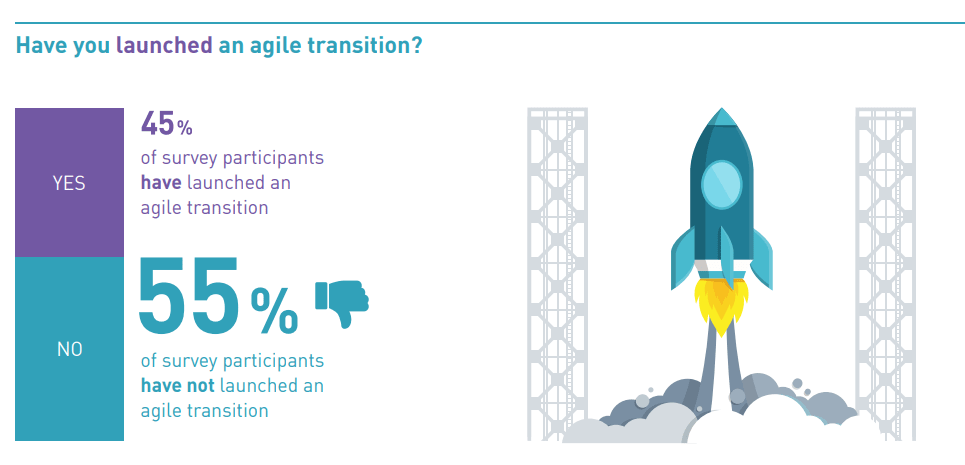
The reason is simple. In most companies, the Scrum master — or Agile coach — is the person most versed in Agile principles. The Scrum framework is their specialty, but it directly builds on Agile.
Not only that, they’re accustomed to taking on a coaching role and leading by example. If you can scale that beyond a single team, why wouldn’t you?
What makes a Scrum master different from a project manager?
Unlike a project manager, a Scrum master isn’t part of a top-down hierarchy. So they’re not a leader or manager in a traditional sense.
In a Scrum team, the team members organize themselves. Every team member knows their role and will actively take on or assign each other appropriate tasks.
Let’s take a look at how these different team structures stack up on paper.

The contrast in the hierarchy is what leads to the core differences between these 2 roles.
A project manager (PM) actively controls the scope, schedule, and assignment of resources for a project.
Broadly speaking, they focus on making sure that the project turns out according to plan.
- A PM controls the overall direction of the project and manages the scope
- They assign deliverables and tasks directly to teams or individual members
- And they get the final say on scheduling and budget decisions
- They manage and reshuffle resources to solve issues during the project
A Scrum master is a servant leader in a self-organizing team. They don’t make any big unilateral decisions. Instead, they help the team trust the process and make decisions of their own.
- A Scrum master coaches the team on Scrum and Agile principles
- They help the team remain productive during Scrum events
- And they assist the team with identifying and avoiding roadblocks to completing their self-assigned deliverables
If a Scrum master needs to step in to assign work or make other important decisions, a team is no longer self-organizing.
It’s this concept that makes the switch to Scrum so hard for teams and managers set in their ways. But it’s also that fundamental difference that makes it so effective.
Scrum master certification: is it a must?
The vast majority of professional Scrum masters are certified.
In a 2019 survey by scrum.org, 83% responded that they completed Scrum master training and received their diploma.
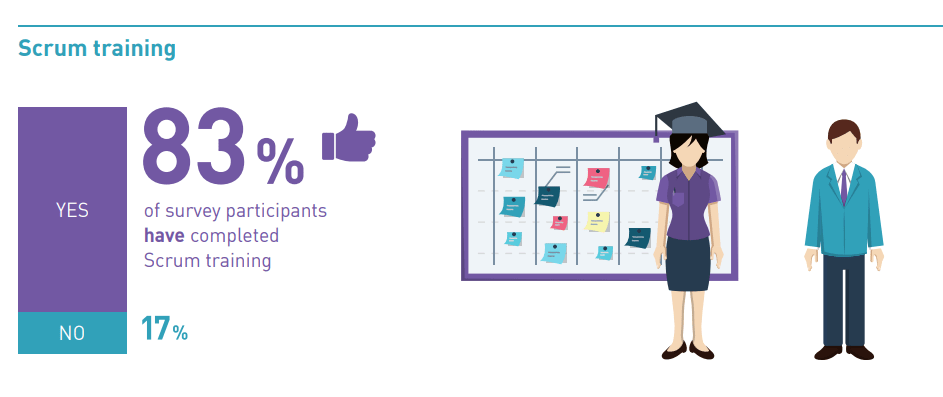
And it makes sense. The ecosystem for training and certification is well-established both on and offline.
You can get in-person training in most major cities globally — even smaller ones, if you’re in the right place. And of course, you can take online courses from anywhere in the world.
Okay, but what’s the big deal? Why should you bother getting a plaque that proves you know what you’re doing?
For the same reason that many professionals pause their careers to get an MBA in their mid-40s — it pays off.
Certified Scrum masters earn more
According to Scrum.org data, certification has a significant impact on the salary of Scrum masters. On average, they earn more, and nearly everyone in the highest-income bracket ($150,000+) are certified.
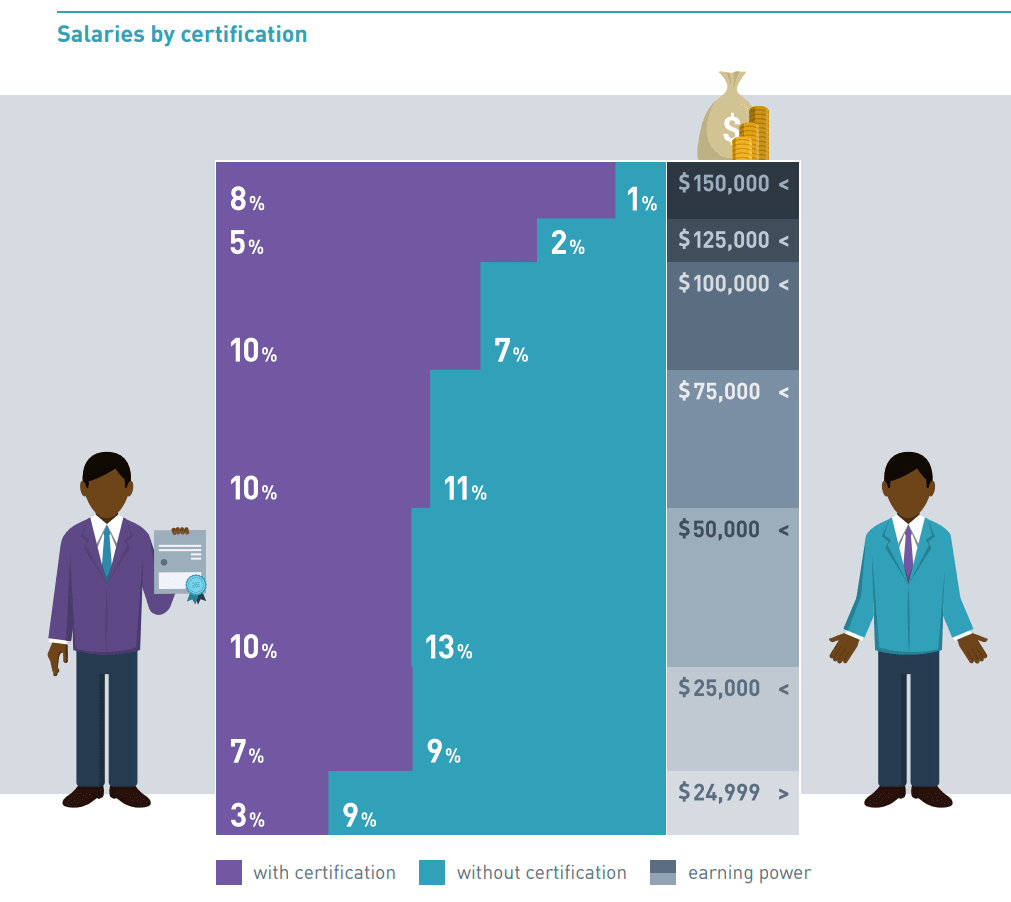
Can you get started without official certification? Sure. Does it make sense to stay uncertified after you get familiar with the Scrum process? No.
To best leverage your skillset, you’ll want to add Scrum certification to your toolbox and CV.
But if you decide to get a certificate, which should you choose? Let’s compare some of the most popular options.
What Scrum master certifications are the most popular?
According to the same study, the most popular certification was the Professional Scrum Master (PSM) 1 from scrum.org.

The second most popular certification was Certified ScrumMaster (CSM) by Scrum Alliance.
The main difference between the 2 is that CSM certification requires a mandatory training course before you can take the certification exam.
A course typically costs between $1,000–2,000, depending on your location.
With PSM, you can read up online, and all you have to do is pay the $150 and take the online assessment.
So while one is cheaper and more accessible, the other gives your potential employer a guarantee that you’ve received at least a bare minimum of training.
7 best practices that will make you a better Scrum master
Still new to your role and Scrum in general?
Follow these 7 best practices to become a better Scrum master and contribute more to your team.
Get out of the way of your team
The first commandment of a Scrum master is that you shouldn’t try to be a regular manager. Trust your team to self-organize and work to support them. Don’t create extra hoops for them to jump through beyond essential Scrum events and processes.And don’t make calls like accepting change requests from executives without running it by the team and product owner.
Focus on engaging your team members
According to Gallup, workplace engagement is a massive differentiator in the productivity and overall success of companies.
An engaged workforce is less absent, stays longer, works safer, and is more productive.

As a Scrum master, the best way to do this is to make the sprints — where work is developed — and Scrum events as smooth and efficient as possible.
Work actively to predict and avoid roadblocks to stop work becoming a painful drudge or a waiting game. The daily Scrum meeting is your best tool here.
When everyone can work on their preferred task and progress as a team, they can’t help but engage with their work.
Collaborate closely with the product owner
While technically a servant leader, it’s also your responsibility to make sure that the product owner’s vision comes to life.
You should fully understand their vision and priorities. Without that insight, you won’t be able to nudge the team in the right direction when necessary.
Be the voice of reason
Let the team organize themselves, sure. But step in as a voice of reason if the product owner or team members are blatantly too optimistic — or if they’ve started to settle and aim too low.
You should understand the capacity of your team better than anyone. So make sure the scope of a sprint is on point.
We recommend working with a buffer of at least 2SP (story points) — defined as full workdays — during any 2-week sprint.
Make sure stakeholders and team members are heard
In a 2020 Wellingtone survey, project management professionals highlight stakeholder engagement as the highest-value process.
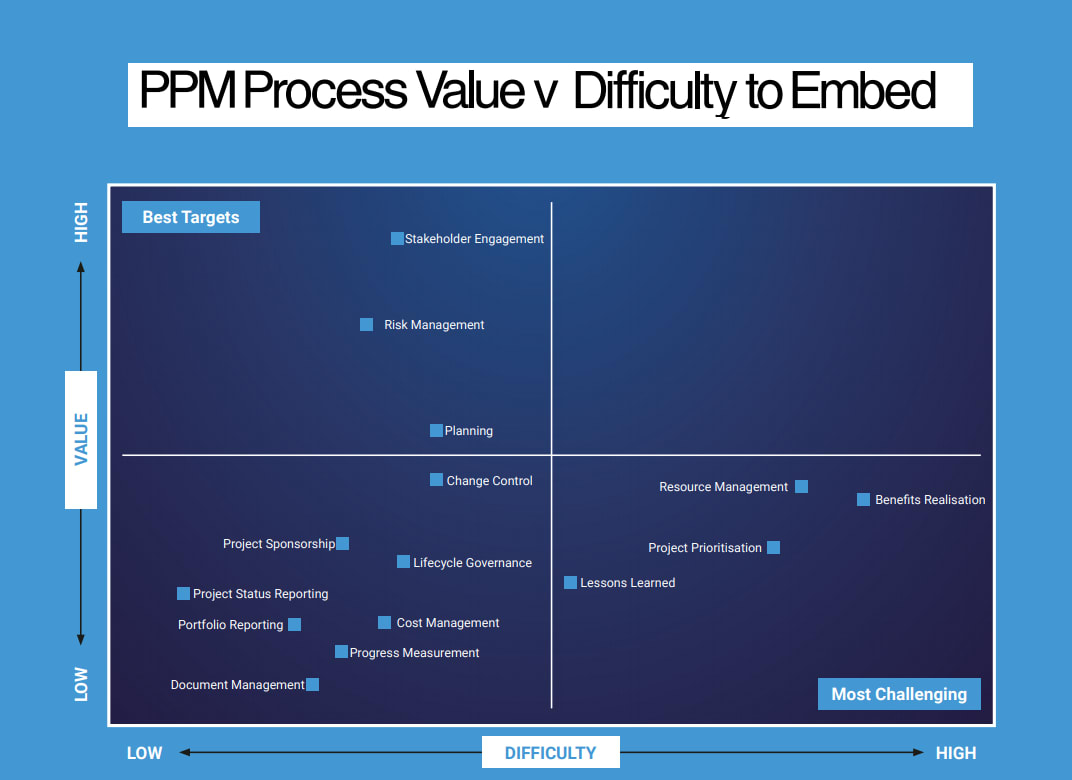
It’s your job to make sure that both team members and stakeholders respect each other’s perspectives. Without taking both into account when planning or reviewing a sprint, you’ll likely miss the mark.
Both stakeholders and team members have valuable insights to offer. But, on occasions, there can be some tension between stakeholders and project team members.
If the project isn’t proceeding according to plan, things can get ugly.
Act as a mediator between them, avoid finger pointing, and make sure that you consider both sides in all Scrum ceremonies.
Phase yourself out of the process
A team new to Scrum tends to rely heavily on your knowledge of the framework and deliverables.
That can lead to a bottleneck while people wait for your feedback. It’s easy to take on too much work.
Don’t settle for that. Continually coach all team members in the process to the point where you start to phase yourself out.
Once the whole team consistently crushes every sprint — including identifying areas for improvement — your job is done.
Be agile about “the rules”
While certain elements are crucial to Scrum, enforcing every little detail can be counterproductive.
Knowing which battles to pick is crucial for a good Scrum master. Internalizing and living the larger principles is more important than following everything to the letter.
Small adaptations to suit a workflow or environment shouldn’t be taboo.
How monday.com makes the job of a Scrum master easier
If you’re serious about improving how your team handles a project, you also need to tackle how to communicate and collaborate.
If everyone’s working in the same office, a whiteboard and in-person daily Scrum meetings may seem like enough.
But whenever someone’s out of the office, they can’t see the key Scrum artifacts — product backlog, sprint backlog, and other notes. Ideally, everyone should be able to access these files at all times.
With monday.com, you can create the project management platform that your company needs. Use automations, integrations, and customizable templates to help your team get more done.
Keep a distributed or hybrid team up to speed
74% of companies are planning to move at least some positions remote full-time. In IT and software development, many teams are already hybrid or distributed teams.
An email thread — or unstructured chat channel — isn’t enough to solve this problem. Information can easily get lost or misinterpreted, leading to duplicate work or avoidable mistakes.
With our Work OS, you can easily keep all assignments and communication organized.
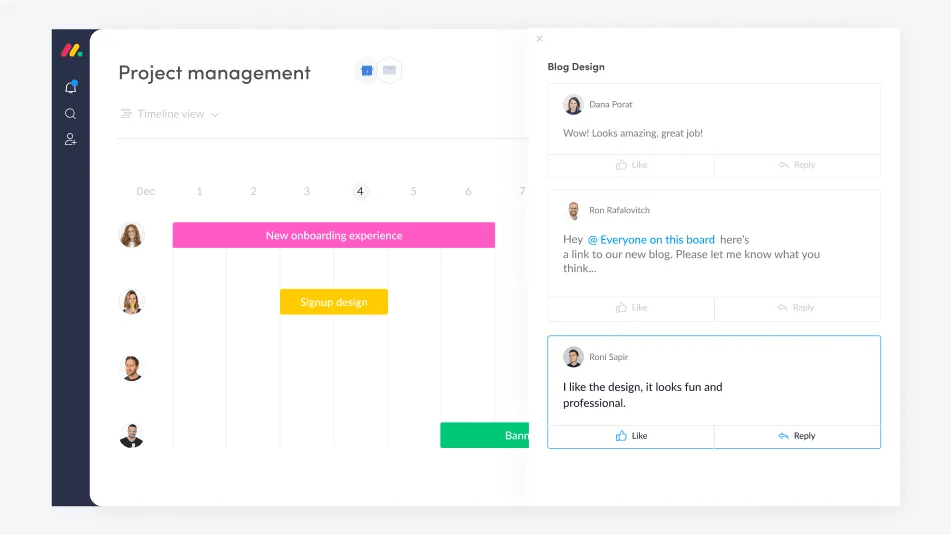
Leave threaded comments and mentions to keep everyone up to speed.
Maintain a shared product backlog with the team and stakeholders
monday.com makes it easy to create and maintain a product backlog. You can use our template to set it up in a few minutes.

With guest accounts and user access control, you can easily share the backlog with relevant stakeholders. You can give the project sponsor, executives, and other VIPs editor access, with the rest on view-only.
Collaborate on prioritizing user stories or features for upcoming sprints. That can help you populate your backlog with potential issues.
You can also use our integrations to import relevant tickets — like bug reports — from a helpdesk, CRM, or email client.
Create a custom Scrum sprint board that suits your workflow.
Once you’ve prioritized specific user stories, it’s time to create the sprint backlog and board. Our template focuses on Scrum basics, but you can easily adjust it to suit your workflow.

If you set expected SP or even milestones, it’s easier to evaluate in the Scrum retrospective. You can quickly see which stories or features you underestimated or where something went wrong.
Real-time communication and notifications reduce bottlenecks
The last thing you want to happen during a sprint is for your team to be stuck waiting. Bottlenecks and roadblocks are the #1 enemy of many a Scrum team and master.
With comments and mentions with notifications directly on the relevant tasks, your team can recruit help faster. Don’t lose valuable time. Sprint as fast as you can.
Automate menial tasks to let team members focus on their work
By letting the doers concentrate on doing, you make it easier for them to stay focused and meet work deadlines. In monday.com, you can automate basic tasks like updating data across boards or notifying someone when an item is overdue or changes status.
But even more useful is how you can use our wide-ranging integrations to automate your entire process.
For example, you can use our integration with Jira to synchronize issues with work items. Or, you can update the status when someone commits code in Github.

Nobody likes manual data entry. So, make the workplace more fun and engaging for your team by eliminating as much of it as possible.
Facilitation over micro-management
A Scrum master isn’t the same as a project manager. Instead, they have more in common with an informal team lead or coach.
To deliver the most value as a Scrum master in your company, you need to double down on facilitation, making it easy for your team to work efficiently within the confines of Scrum.
A core concept of Scrum is the self-organized team. Don’t get in the way of that.
Instead, use and customize our Scrum planning template to make it easy for everyone to collaborate.

